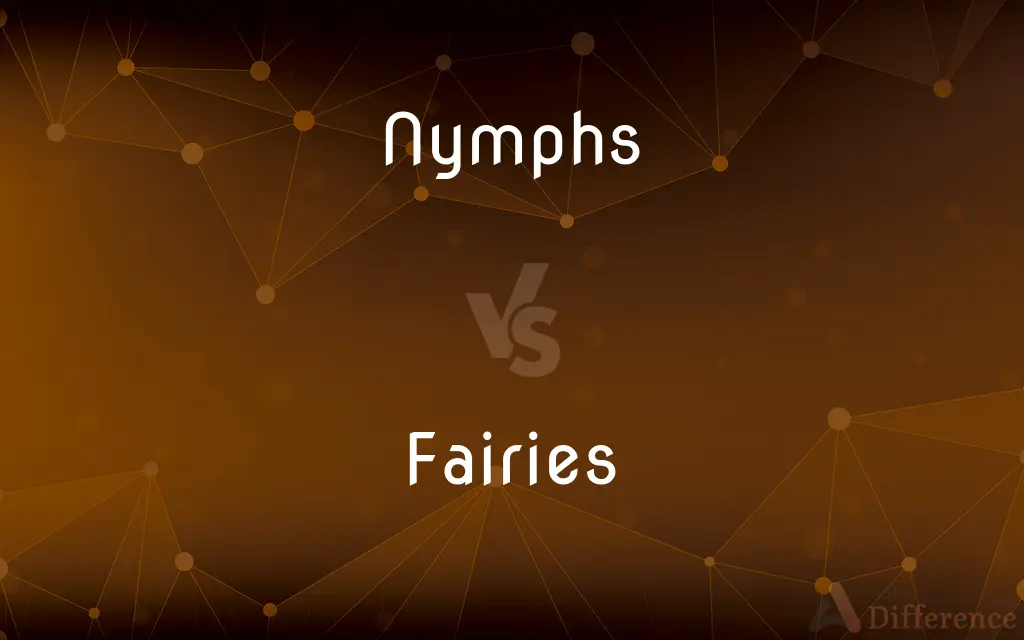Nymphs vs. Fairies — What's the Difference?
Edited by Tayyaba Rehman — By Fiza Rafique — Published on December 13, 2023
Nymphs are nature deities from Greek mythology, often linked to specific natural elements, while Fairies are magical beings from European folklore, known for their mischief and connection to nature.

Difference Between Nymphs and Fairies
Table of Contents
ADVERTISEMENT
Key Differences
Nymphs hail from Greek mythology and are seen as lesser deities of nature, often associated with particular landscapes such as forests, rivers, or mountains. Fairies, on the other hand, span a wider range of European folklore and myths, often depicted as tiny, magical beings with wings, although descriptions can vary significantly.
While Nymphs typically have a benevolent or neutral disposition and serve higher deities or natural entities, Fairies are known for their playful and sometimes mischievous behavior, and they may either help or hinder humans. Fairies have a rich folklore that includes tales of them stealing children, playing tricks, or granting wishes.
The physical depictions of these entities also differ. Nymphs are usually portrayed as beautiful young maidens directly tied to specific natural elements. In contrast, Fairies can range from beautiful to grotesque, and while many are imagined with wings, this is not universal.
Both Nymphs and Fairies are integral parts of their respective mythologies and represent humanity's deep connection and reverence for nature. However, while Nymphs are more rigidly defined by their Greek origins, Fairies have more fluid definitions and characteristics, influenced by various cultures across Europe.
Comparison Chart
Origin
Greek mythology
European folklore
ADVERTISEMENT
Association
Specific natural elements or locations
General nature and mischief
Behavior
Typically benevolent or neutral
Playful, mischievous, can be good or bad
Physical Depiction
Beautiful maidens
Range from beautiful to grotesque; often with wings
Role
Serve higher deities or natural entities
Act on their own, may interact with humans in various ways
Compare with Definitions
Nymphs
Lesser deities from Greek mythology.
The Nymphs of the forest were said to protect the trees and animals.
Fairies
Magical beings from European folklore.
Fairies often dance in circles during the moonlit nights.
Nymphs
Protectors or spirits of specific nature locations.
The mountain Nymphs would sing songs on breezy days.
Fairies
Entities known for mischief and playful behavior.
It was said that Fairies would sometimes borrow things without asking.
Nymphs
Benevolent or neutral entities serving higher powers.
The Nymphs were often seen in the company of gods like Artemis.
Fairies
Beings with a connection to nature and the supernatural.
Fairies were believed to guard certain ancient trees.
Nymphs
Beautiful maidens linked to natural elements.
A river Nymph could be found at the heart of every flowing waterway.
Fairies
Characters in numerous legends, tales, and ballads.
There's a famous tale where Fairies grant wishes to a kind-hearted soul.
Nymphs
Greek & Roman Mythology Any of numerous minor deities represented as beautiful maidens inhabiting and sometimes personifying features of nature such as trees, waters, and mountains.
Fairies
Often depicted with wings, but not always.
The Fairies in her garden were so small they could hide under the leaves.
Nymphs
A sexually mature and attractive young woman.
Fairies
An imaginary being in human form, depicted as clever, mischievous, and possessing magical powers.
Nymphs
The immature form of an insect, such as a grasshopper, that does not pass through a pupal stage during metamorphosis. Nymphs resemble adults but are smaller and lack fully developed wings.
Fairies
Offensive Slang Used as a disparaging term for a gay man.
Nymphs
The eight-legged immature form of certain arachnids, such as ticks and mites.
Fairies
Plural of fairy
Nymphs
Plural of nymph
Fairies
Plural of fairie
Nymphs
Immortal beings representing aspects of nature.
Some Nymphs were believed to have healing abilities.
Common Curiosities
Are Fairies always depicted with wings?
No, while many Fairies are depicted with wings, it's not universal.
Where do Nymphs originate from?
Nymphs originate from Greek mythology.
Do Fairies have a mischievous nature?
Yes, Fairies are often known for their playful and sometimes mischievous behavior.
Can Nymphs be found outside of Greek mythology?
While Nymphs primarily belong to Greek mythology, similar nature spirits can be found in other cultures' myths.
Are there male Fairies?
Yes, folklore includes both male and female Fairies.
Do Nymphs have a particular role in Greek myths?
Nymphs often serve higher deities or represent certain aspects of nature in Greek myths.
Are Nymphs associated with specific natural locations?
Yes, Nymphs are often tied to specific natural elements or locations like rivers, forests, or mountains.
Can Fairies grant wishes?
Some tales and folklore suggest Fairies have the power to grant wishes.
Are Nymphs immortal?
Generally, Nymphs are considered immortal, though not all-powerful.
What's the most common depiction of Fairies?
Fairies are commonly depicted as tiny, magical beings, often with wings, but depictions can vary.
How are Nymphs typically portrayed?
Nymphs are typically portrayed as beautiful young maidens.
Are Nymphs and Fairies related?
While both are connected to nature, they originate from different mythologies and have distinct characteristics.
Are Fairies considered good or evil?
Fairies are morally ambiguous; they can be good, bad, or neutral.
Do Nymphs have specific names?
Yes, some Nymphs have specific names based on their association, like Dryads (forest Nymphs) or Naiads (water Nymphs).
Can Fairies shape-shift?
Some folklore suggests Fairies have the ability to change their appearance or turn into animals.
Share Your Discovery

Previous Comparison
Scent Booster vs. Fabric Softener
Next Comparison
Rebonding vs. StraighteningAuthor Spotlight
Written by
Fiza RafiqueFiza Rafique is a skilled content writer at AskDifference.com, where she meticulously refines and enhances written pieces. Drawing from her vast editorial expertise, Fiza ensures clarity, accuracy, and precision in every article. Passionate about language, she continually seeks to elevate the quality of content for readers worldwide.
Edited by
Tayyaba RehmanTayyaba Rehman is a distinguished writer, currently serving as a primary contributor to askdifference.com. As a researcher in semantics and etymology, Tayyaba's passion for the complexity of languages and their distinctions has found a perfect home on the platform. Tayyaba delves into the intricacies of language, distinguishing between commonly confused words and phrases, thereby providing clarity for readers worldwide.












































